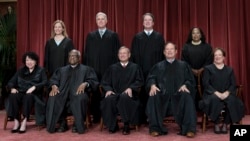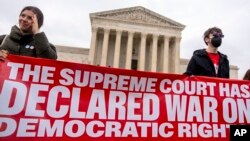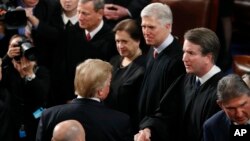The U.S. Supreme Court's most well-known decisions are decided on what is referred to as the court's merits docket. These include high-profile cases like Brown v. Board of Education, which outlawed racial segregation in schools, and the now-overturned Roe v. Wade, which established abortion as a fundamental right.
But many more of the court's activities happen on the much lesser-known emergency docket. University of Chicago law professor William Baude coined this less-transparent part of the court's work as the "shadow docket."
"It sounds very nefarious, but it actually describes something that's very long standing," says Josh Blackman, a professor of constitutional law at the South Texas College of Law Houston. "In some urgent cases, the courts can decide an issue quickly. They don't have oral arguments before the court. They don't have the usual six-month-long briefing schedule. Everything's done fairly quickly, sometimes in the span of days or even weeks."
Stephen Vladeck, a lawyer and author of The Shadow Docket: How the Supreme Court Uses Stealth Rulings to Amass Power and Undermine the Republic, says the shadow docket accounts for a big part of the court's work.
"By volume, the merits cases really are only about 1% of what the Supreme Court does and of the rulings the Supreme Court hands down," Vladeck says. "And the other 99%, which includes decisions whether or not to take up particular cases, includes decisions whether to intervene early in a case before it reaches the Supreme Court."
Unlike cases on the merits docket, shadow docket decisions are not accompanied by written briefs explaining the justices' reasoning.
"The typical order on the shadow docket is not signed. It has no explanation. It has no rationale," says Vladeck, a faculty member at the University of Texas School of Law. "These are really important things the Supreme Court is doing. … I think the way to make it accessible is to try to explain to folks exactly what the court is being asked to do, exactly what it's doing, and exactly which effects those rulings are producing."
An unsigned decision means that a majority of justices — at least five — agree with the order. Sometimes justices will write about whether they concur or disagree with the unsigned order. However, when they don't, it can be impossible to know where the justices stand on the issue.
John Yoo is a law professor at the University of California, Berkeley, School of Law. He clerked for Supreme Court Justice Clarence Thomas in the 1990s, and says the shadow docket is like a preview of high court decisions to come.
"Someone in the lower court is saying, 'Please freeze the proceedings, because we might be losing and by the time we can get to the Supreme Court, we will be harmed irreparably. It'll be too late," Yoo says. "And so, with the emergency docket, what the court's essentially doing is it's freezing something in place because it thinks it's probably going to agree."
Traditionally, issues on the emergency docket were noncontroversial procedural matters and individual death penalty cases that did not have far-reaching impact. But Vladeck is concerned that, particularly during the Trump administration, the Supreme Court used unexplained orders more and more.
"It's a problem when the output of that secret, unexplained work is simultaneously, 1) producing massive effects in the real world and 2) in ways that are at least superficially inconsistent, ... where it doesn't seem like there's a neutral legal principle doing work so much as it seems like the partisan balance of the dispute is explaining the outcome," Vladeck says.
Yoo contends that increased use of the shadow docket doesn't favor conservatives or liberals, that it's just an accelerated way to challenge the government.
"It's not the court that really wants to do this," Yoo says. "I think it's litigants raising these kinds of questions in a faster way, more speedy way, than they used to. And I think the justices, if they had their druthers, would probably prefer that these cases not come up in this emergency rushed way."
During the Bush and Obama administrations, the federal government asked the high court for emergency relief a total of eight times. The Trump administration went to the court, and its new conservative majority, a total of 41 times.
Although the shadow docket was used quite often during the Trump presidency and the pandemic, Blackman says use of the emergency docket has slowed in the past couple of years.
"To the extent that there was a problem, I think that problem sort of faded," says Blackman, who feels Vladeck's concerns are overblown. "It became very salient again during COVID and Trump – these two once-in-a-lifetime phenomena that converged around the same time. … COVID has now, thankfully, faded [and President Joe] Biden doesn't use it as much."
There is further evidence that the court could be self-correcting.
Justices Amy Coney Barrett and Brett Kavanaugh, both Trump appointees, have signaled their reluctance to perpetually use the shadow docket. While there have been calls for Supreme Court reform, a presidential commission appointed by President Biden did not recommend any.
"This is something that people propose over the years when they're angry at the Supreme Court," Yoo says. "But, in general, the best thing is just to leave things as they are. There doesn't seem to be any serious structural problem with the way the court is monitoring its docket and the way jurisdiction is being exercised."











